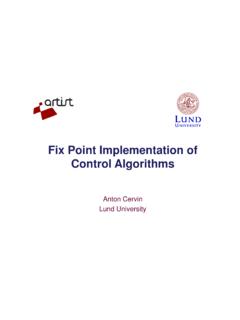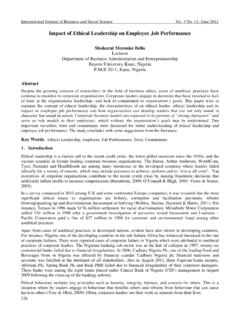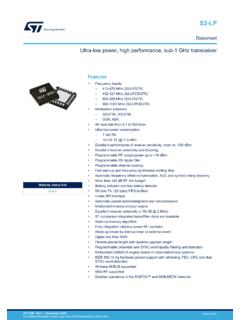Transcription of 1. Introduction to Embedded System Design
1 1 - 1 Swiss FederalInstitute of TechnologyComputer Engineeringand Networks Laboratory 1. Introduction to Embedded System Design Lothar ThieleETH Zurich, Switzerland1 - 2 Swiss FederalInstitute of TechnologyComputer Engineeringand Networks Laboratory Contents of Lectures (Lothar Thiele)1. Introduction to Embedded System Design2. Software for Embedded Systems3. Real-Time Scheduling4. Design Space Exploration5. performance AnalysisThe slides contain material from the Embedded System Design Book and Lecture of Peter Marwedel and from the Hard Real-Time Computing Systems Book of Giorgio - 3 Swiss FederalInstitute of TechnologyComputer Engineeringand Networks Laboratory TopicsGeneral Introduction to Embedded SystemsHardware Platforms and Components!
2 System Specialization!Application Specific Instruction Sets Micro Controller Digital Signal Processors and VLIW!Programmable Hardware!ASICs! System -on-Chip1 - 4 Swiss FederalInstitute of TechnologyComputer Engineeringand Networks Laboratory Main reason for buying is notinformation processingEmbedded systems (ES) = information processing systems Embedded into a larger productExamples: Embedded Systems1 - 5 Swiss FederalInstitute of TechnologyComputer Engineeringand Networks Laboratory Embedded Systemsexternal processembedded systemhuman interfacesensors, actuators1 - 6 Swiss FederalInstitute of TechnologyComputer Engineeringand Networks Laboratory Examples of Embedded SystemsCar as an integrated control-, communication and information boxmotor controlclimate controlinformation1 - 7 Swiss FederalInstitute of TechnologyComputer Engineeringand Networks Laboratory Examples of Embedded SystemsConsumer electronics, for example MP3 Audio, digital camera, home electronics.
3 Sensorsactuatorsuser interfaceprocessor1 - 8 Swiss FederalInstitute of TechnologyComputer Engineeringand Networks Laboratory Examples of Embedded SystemsProduction systems1 - 9 Swiss FederalInstitute of TechnologyComputer Engineeringand Networks Laboratory Examples of Embedded SystemsInformation systems, for example wireless communication (mobile phone, Wireless LAN, ..), end-user equipment, router, ..1 - 10 Swiss FederalInstitute of TechnologyComputer Engineeringand Networks Laboratory Communicating Embedded SystemsExample: BTnodes ( )!complete platform including OS!especially suited for pervasive computing applicationsSensorActuator1 - 11 Swiss FederalInstitute of TechnologyComputer Engineeringand Networks Laboratory BTnode Platformgeneric platform for ad-hoc computingcomplete platform including OSespecially suited for pervasive computing applicationsCommunication via Bluetooth TransceiverData InterfacesMicroprocessor and MemoryBatteries2ndRadio1 - 12 Swiss FederalInstitute of TechnologyComputer Engineeringand Networks Laboratory Communicating Embedded Systems!
4 Sensor networks (civil engineering, buildings, environmental monitoring, traffic, emergency situations)!smart products, wearable/ubiquitous computingMICSMICS1 - 13 Swiss FederalInstitute of TechnologyComputer Engineeringand Networks Laboratory Characteristics of Embedded Systems (1)Must bedependable:!Reliability:R(t)= probability of System working correctly provided that is was working at t=0!Maintainability:M(d)= probability of System working correctly dtime units after error occurred.!Availability:probability of System working at time t!Safety:no harm to be caused!Security:confidential and authentic communicationEven perfectly designed systems can fail if the assumptions about the workload and possible errors turn out to be the System dependable must not be an after-thought, it must be considered from the very - 14 Swiss FederalInstitute of TechnologyComputer Engineeringand Networks Laboratory Characteristics of Embedded Systems (2)Must be efficient:!
5 Energyefficient!Code-sizeefficient (especially for systems on a chip)!Run-timeefficient!Weightefficient! CostefficientDedicatedtowards a certain application: Knowledge about behavior at Design time can be used to minimize resources and to maximize interface(no mouse, keyboard and screen).1 - 15 Swiss FederalInstitute of TechnologyComputer Engineeringand Networks Laboratory Characteristics of Embedded Systems (3)Many ES must meet real-time constraints:!A real-time System must react to stimulifrom the controlled object (or the operator) within the time interval dictated by the environment.!For real-time systems, right answers arriving too late (or even too early) are wrong. A real-time constraint is called hard, if not meeting that constraint could result in a catastrophe [Kopetz, 1997].
6 !All other time-constraints are called soft.!A guaranteed System responsehas to be explained without statistical - 16 Swiss FederalInstitute of TechnologyComputer Engineeringand Networks Laboratory Characteristics of Embedded Systems (4)Frequently connected to physical environmentthrough sensors and actuators,Hybrid systems(analog + digital parts).Typically, ES are reactive systems: A reactive System is one which is in continual interaction with is environment and executes at a pace determined by that environment [Berg , 1995]!Behavior depends on input and current state."automata model often appropriate,1 - 17 Swiss FederalInstitute of TechnologyComputer Engineeringand Networks Laboratory ComparisonEmbedded Systems!
7 Few applications that are known at Design -time.!Not programmable by end user.!Fixed run-time requirements (additional computing power not useful). !Criteria: cost power consumption predictability ..General Purpose Computing!Broad class of applications.!Programmable by end user.!Faster is better.!Criteria: cost average speed1 - 18 Swiss FederalInstitute of TechnologyComputer Engineeringand Networks Laboratory TopicsGeneral Introduction to Embedded SystemsHardware Platforms and Components! System Specialization!Application Specific Instruction Sets Micro Controller Digital Signal Processors and VLIW!Programmable Hardware!ASICs! System -on-Chip1 - 19 Swiss FederalInstitute of TechnologyComputer Engineeringand Networks Laboratory Embedded System HardwareEmbedded System hardware is frequently used in a loop( hardware in a loop ).
8 Actuatorsembedded systemthis course1 - 20 Swiss FederalInstitute of TechnologyComputer Engineeringand Networks Laboratory Typical ArchitectureMicroprocessor 4, 8, 16, 32, 4 bit bus CISC, RISC, DSP Integrated peripherals Debug/Test Port Caches Pipeline Multiprocessing SystemsDEBUG PortNon-volatile memory EPROM, FLASH, DISK HybridVolatile Memory DRAM, SRAM HybridCustom Devices ASIC FPGA PALS tandard Devices I/O Ports Peripheral ControllersCommunication Devices Ethernet RS-232 SCSI Centronics ProprietaryMicroprocessor Bus Custom PCI VME PC-102 System Clocks RTC circuitry System clocks Integrated in uC Imported/ExportedPeripheral BusSoftware Application Code Driver Code / BIOS Real Time Operating System User Interface Communications Protocol Stacks C, C++, Assembly Language, ADA Legacy CodeTo Outside World1 - 21 Swiss FederalInstitute of TechnologyComputer Engineeringand Networks Laboratory TopicsGeneral Introduction to Embedded SystemsHardware Platforms and Components!
9 System Specialization!Application Specific Instruction Sets Micro Controller Digital Signal Processors and VLIW!Programmable Hardware!ASICs! System -on-Chip1 - 22 Swiss FederalInstitute of TechnologyComputer Engineeringand Networks Laboratory Implementation AlternativesPerformancePower EfficiencyFlexibilityApplication-specifi c integrated circuits (ASICs)Application-specific instruction set processors (ASIPs) Microcontroller DSPs (digital signal processors)General-purpose processorsProgrammable hardware FPGA (field-programmable gate arrays)1 - 23 Swiss FederalInstitute of TechnologyComputer Engineeringand Networks Laboratory General-purpose ProcessorsHigh performance !Highly optimized circuits and technology!
10 Use of parallelism superscalar: dynamic scheduling of instructions super-pipelining: instruction pipelining, branch prediction, speculation!complex memory hierarchyNot suited for real-time applications!Execution times are highly unpredictable because of intensive resource sharing and dynamic decisionsProperties!Good average performance for large application mix !High power consumption1 - 24 Swiss FederalInstitute of TechnologyComputer Engineeringand Networks Laboratory Pentium P41 - 25 Swiss FederalInstitute of TechnologyComputer Engineeringand Networks Laboratory System SpecializationThe main difference between general purpose highest volume microprocessors and Embedded systems is should respect flexibility!











